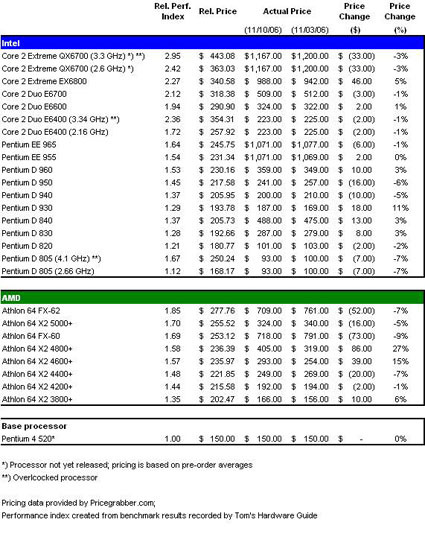Intel quad-core QX6700 makes official debut in price/performance charts
Chicago (IL) - The holiday shopping season begins to kick into gear these weeks, marked by a handful of the biggest electronics debuts of the entire year. On the CPU side, average prices of current processors for the Intel and AMD have formed two completely different trends, the latest edition of our price/preformance processor charts reveal.
Average prices for Intel processors have been the most steady week-to-week this time around since we started monitoring the prices again in the first week of October. On average, from the processors we looked at, average prices shifted just 0.5%. AMD, on the other hand, had one of the most defined set of price swings that we've seen in recent memory.
Click to enlarge
Especially noteworth this week is that, aggregately, price changes between Intel and AMD were not all that different. On total, prices of Intel's processors went up $44, while those on the AMD side fell $28. However, the standard deviation of change for AMD is nearly four times that of Intel. The largest absolute price change for Intel this week was the Core 2 Duo Extreme X6800, which went up by $46, or $942 to $988 as a sign of slowly but noticeably accelerating Christmas sales.
Buyers looking to the high-end right now should keep in mind that Intel will launch a new flagship desktop CPU next week, the Core 2 Extreme QX6700 quad-core CPU. In fact, some e-tailers have already set the availability of their QX6700 to "in stock," which enabled us to remove the pricing speculation around the QX6700 of recent weeks. The average etail pricing for the QX6700, which we are introducing this week, is now based on actual pre-order estimates. As it turns out, our $1200 prdiction was right on target.
As far as Intel is concerned, though, pricing was not a big story. Most average processor prices shifted from between 7% and less than 1%.
AMD is a different story entirely. Readers may recall that, last week, AMD saw some pretty defined price jumps, especially on the FX side. We attributed this to the upcoming release of AMD's new 4x4 platform, which, according to some sources will be heading out on November 14 and, according to others, more twopards the very end of this month. With the new debut now closer than ever, prices on these FX processors have settled down to where they were two week ago. The Athlon 64 FX-60, for example, fell $52, or 7%, down to $709 from $761. On October 27, the average price was $727, so it is more or less back to where it should be.
Get Tom's Hardware's best news and in-depth reviews, straight to your inbox.
The FX-60 also climbed down a bit from its astronomical $791 price, but it is still more expensive than the FX-62. Based on performance alone, the FX-60 should be 9% less expensive than the FX-62. Instead, right now it's 8% more expensive. As the overall prices begin to fall back into a more reasonable range, and continue to feel the effects of the official AMD price cuts announced a couple weeks ago, the pricing should hopefully straighten out to put AMD back into a strong price/performance position like we're used to seeing. As of now, it is unclear how the introduction of (socket 1207) 4x4 will impact (socket AM2) FX pricing. If AMD in fact is able to provide a substantial amount of 4x4 packages and if it is able to keep its $1000 pricing promise than recent processor pricing history could hint towards a price drop of (AM2) FX CPUs.
Also very much worth mentioning are the price shifts on AMD's other processors. In terms of price drops, the 5000+ and 4400+ also chimed in, each with price decreases in the $18, 6% range. However, to round out all the price falls that were seen this week were the two processors that had the biggest relative price jumps out of all of AMD and Intel.
Perhaps one of the most unexpected changes was the average price of the 4800+. Since our new coverage of processor pricing began on October 6, and up until last week, the price of the 4800+ was the only processor out of all the ones from Intel and AMD that had continually dropped in price. This week it rose $86, or 27%, to provide the most defined price jump of the week. It went from $319 to $405, giving it the most expensive price we've seen for the 4800+ in the past six weeks.
The 3800+ also rose to the most expensive price we've seen since October 6, though its price has always been fairly constant, this week seeing just a 6% jump from $156 to $166. Not to be outdone, the 4600+ also jumped a fairly significant amount, up $39 from $254 to $293, a 15% increase.
Tom's Hardware is the leading destination for hardcore computer enthusiasts. We cover everything from processors to 3D printers, single-board computers, SSDs and high-end gaming rigs, empowering readers to make the most of the tech they love, keep up on the latest developments and buy the right gear. Our staff has more than 100 years of combined experience covering news, solving tech problems and reviewing components and systems.

